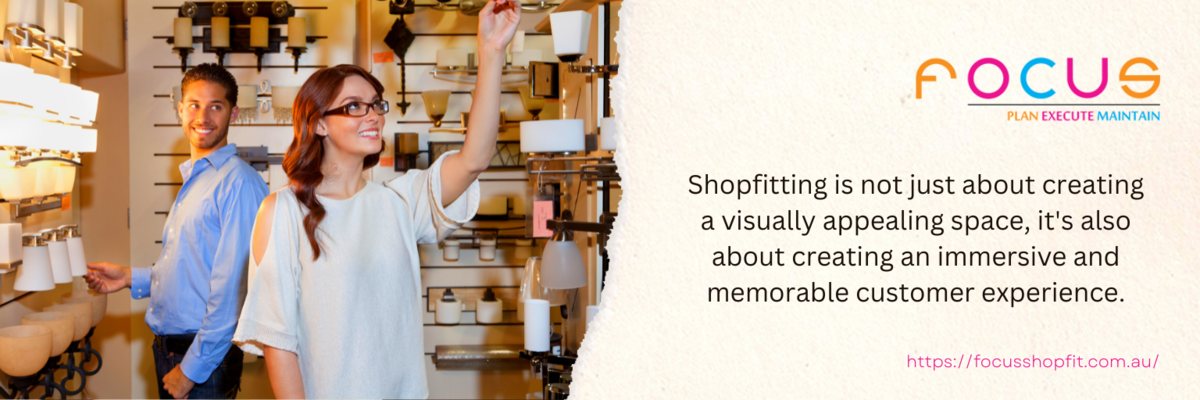Shopfitting plays a crucial role in creating a visually appealing and functional retail space. In Australia, where the retail industry continues to thrive, shopfitting is more important than ever. It involves the design, construction, and installation of fixtures and fittings in retail stores, ensuring that the space is optimized for both customers and businesses.

A well-executed shopfitting project can enhance the overall shopping experience, attract more customers, and ultimately increase sales. It involves proper planning, coordination, and great attention to detail. From choosing the right materials and designs to incorporating the latest technology, shopfitting can transform a retail space into a thriving and immersive environment.
The Importance of Shopfitting in Retail Spaces
Shopfitting is not just about making a store look good; it is about creating an environment that encourages customers to explore, engage, and make purchases. In Australia, where competition among retailers is fierce, shopfitting has become a crucial aspect of staying ahead in the market. When done right, shopfitting can help retailers:
- Create a Memorable Brand Experience: The design and layout of a retail space can play a significant role in shaping a brand’s identity. Customers are more likely to remember and connect with a store that reflects the values and personality of the brand.
- Optimize Store Layout: Shopfitting involves careful consideration of the flow and layout of a store. By strategically placing displays, shelving, and checkout counters, retailers can guide customers through the store and maximize opportunities for product exposure.
- Enhance Visual Merchandising: Effective shopfitting allows retailers to display their products in an attractive and organized manner. By using lighting, signage, and creative displays, retailers can draw attention to specific products and create a visually compelling shopping experience.
- Improve Customer Satisfaction: A well-designed retail space can make customers feel comfortable and engaged. By considering factors such as lighting, acoustics, and overall ambiance, shopfitters can create an environment that encourages customers to spend more time in the store and make repeat visits.
Emerging Shopfitting Trends in 2024
Several emerging shopfitting trends are set to transform the retail landscape in Australia. These trends reflect the changing preferences and expectations of customers and the advancements in technology.
- Virtual and Augmented Reality: Virtual and augmented reality technologies are revolutionizing the way customers interact with products in-store. From virtual try-on experiences to interactive product demonstrations, these technologies provide immersive and engaging experiences.
- Personalization and Customization: Customers are increasingly looking for unique personalized experiences. In 2024, shopfitting will focus on creating spaces that can be tailored to individual preferences. This includes customizable fixtures, interactive displays, and personalized recommendations.
- Integration of Social Media and Influencer Marketing: Retailers are recognizing the power of social media and influencer marketing in driving sales. Shopfitting in 2024 will incorporate spaces specifically designed for social media-worthy moments, encouraging customers to share their experiences online.
- Smart and Connected Stores: The Internet of Things (IoT) is transforming the way retailers operate. In 2024, shopfitting will involve the integration of smart technologies that enable real-time inventory tracking, personalized promotions, and seamless checkout experiences.
Shopfitting Materials and Designs for 2024
In 2024, shopfitting materials and designs will continue to evolve to meet the changing demands of retailers and customers. Here are some materials and designs that will be on-trend:
- Natural and Sustainable Materials: The use of natural and sustainable materials, such as reclaimed wood, bamboo, and recycled plastic, will continue to gain popularity. These materials not only contribute to a more eco-friendly retail space but also add a touch of warmth and authenticity.
- Minimalistic and Clean Designs: Minimalism has been a popular design trend in recent years and will continue to be favored in 2024. Clean lines, neutral colors, and uncluttered spaces create a sense of calm and allow products to take center stage.
- Mixed Materials and Textures: Combining different materials and textures adds visual interest and depth to a retail space. In 2024, shopfitters will experiment with contrasting materials, such as metal and wood, or matte and glossy surfaces, to create unique and visually appealing displays.
- Biophilic Design: Biophilic design aims to connect people with nature by incorporating natural elements into the built environment. In 2024, expect to see more retail spaces featuring living walls, natural lighting, and organic shapes, creating a harmonious and soothing atmosphere.

Incorporating Technology in Shopfitting
Technology is revolutionizing the way shopfitting is approached and executed. From interactive displays to smart lighting systems, incorporating technology can enhance the overall shopping experience and drive customer engagement. Here are some ways technology is being integrated into shopfitting:
- Interactive Displays: Touchscreens, augmented reality mirrors, and interactive product catalogs allow customers to explore products more engagingly and interactively. These displays provide additional product information, recommendations, and even virtual try-on experiences.
- Smart Lighting Systems: Lighting plays a crucial role in creating the right ambiance and highlighting products. Smart lighting systems can be programmed to adjust color temperature and brightness levels, creating different moods and enhancing the visual appeal of the space.
- Mobile Integration: Mobile devices have become an integral part of the shopping experience. Shopfitting in 2024 will focus on integrating mobile technology, such as mobile payment systems, personalized notifications, and location-based services, to enhance customer convenience and engagement.
- Data Analytics and Artificial Intelligence: Retailers are leveraging data analytics and artificial intelligence to gain insights into customer behavior and preferences. Shopfitting in 2024 will involve the integration of sensors and cameras that can collect data on customer movement, product interactions, and buying patterns, allowing retailers to make data-driven decisions.
Creating an Immersive Customer Experience through Shopfitting
Shopfitting is not just about creating a visually appealing space; it is about creating an immersive and memorable customer experience. In 2024, shopfitters will focus on enhancing the overall shopping journey and creating moments that leave a lasting impression. Here are some strategies to create an immersive customer experience:
- Aesthetic Cohesion: Every aspect of the retail space, from the store layout to the fixtures and displays, should be cohesive and aligned with the brand’s identity. Consistency in design, colors, and materials creates a sense of harmony and reinforces the brand’s message.
- Engaging Visual Merchandising: Visual merchandising is a powerful tool to capture customers’ attention and guide them through the store. In 2024, shopfitters will focus on creating visually compelling displays that tell a story and evoke emotions.
- Multisensory Experiences: Engaging multiple senses can create a more immersive experience. In 2024, shopfitters will incorporate elements such as ambient scents, background music, and interactive displays that appeal to sight, sound, smell, and touch.
- Seamless Customer Journey: A seamless customer journey involves removing any friction points and ensuring a smooth transition from one stage to another. In 2024, shopfitters will focus on optimizing store layouts, wayfinding signage, and checkout processes to enhance convenience and reduce customer frustration.
Shopfitting Tips and Best Practices
To ensure a successful shopfitting project, it is important to follow some key tips and best practices. Here are some guidelines for achieving the best results:
- Plan Ahead: Proper planning is crucial for a successful shopfitting project. Start by defining your store’s goals, budget, and project timeline. Consider factors such as store layout, target audience, and brand identity. Engage with a professional shopfitter early in the process to ensure a smooth execution.
- Collaborate with Professionals: Shopfitting is a complex process that requires expertise in design, construction, and project management. Collaborate with experienced professionals who understand the unique challenges of shopfitting in Australia. They can provide valuable insights and ensure a seamless execution.
- Prioritize Safety and Compliance: Safety should be a top priority in shopfitting projects. Ensure that all fixtures and fittings meet relevant safety standards and comply with local regulations. Engage with professionals who have a strong track record in adhering to safety guidelines.
- Consider Future Flexibility: Retail trends are constantly evolving, and your shopfitting should be able to adapt to changing needs. Consider modular fixtures and flexible layouts that can be easily modified in the future. This will save time and costs when it comes to refreshing your retail space.
Hiring a Professional Shopfitter in Australia
To achieve the best results in shopfitting, it is recommended to hire a professional shopfitter with experience in the Australian market. Here are some factors to consider when selecting a shopfitting partner:
- Industry Expertise: Look for a shopfitter with a proven track record in the retail industry. They should have experience working with various types of retail spaces, from small boutiques to large department stores.
- Portfolio and References: Review the shopfitter’s portfolio and ask for references from previous clients. This will give you an idea of their design capabilities, craftsmanship, and ability to deliver projects on time and within budget.
- Collaborative Approach: A successful shopfitting project requires collaboration between the shopfitter and the retailer. Look for a shopfitter who values open communication, understands your vision, and is willing to work closely with you to achieve your goals.
- Attention to Detail: Shopfitting is a detail-oriented process that requires meticulous attention to detail. Ensure that the shopfitter has a reputation for delivering high-quality workmanship and finishes.

Transforming Your Retail Space with Shopfitting Trends in 2024
Shopfitting is a critical aspect of creating a successful retail space in Australia. By staying up-to-date with the latest trends, incorporating technology, and focusing on creating immersive customer experiences, retailers can transform their stores into thriving and memorable destinations.
Shopfitting will continue to evolve, driven by advancements in technology and changing consumer preferences. By embracing these emerging trends, retailers can stay ahead of the competition and create retail spaces that captivate and engage customers.
If you’re considering a shopfitting project in Australia, remember to plan, collaborate with professionals, and prioritize safety and compliance. By hiring a professional shopfitter with industry expertise, you can ensure seamless execution and achieve the best results for your retail space. Transform your retail space with shopfitting trends in 2024 and create an environment that delights and inspires your customers.
